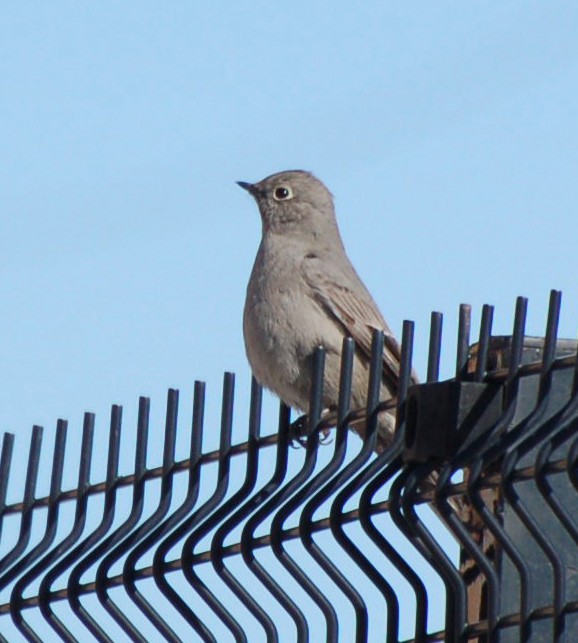Townsend's Solitaire
A species of Typical solitaires and hawaiian thrushes Scientific name : Myadestes townsendi Genus : Typical solitaires and hawaiian thrushes
Townsend's Solitaire, A species of Typical solitaires and hawaiian thrushes
Botanical name: Myadestes townsendi
Genus: Typical solitaires and hawaiian thrushes
Content
Description People often ask General Info
Description
Townsend's solitaire reaches a length of approximately 8–9.5 inches (20–24 cm) and wingspan of 14.5 in (37 cm); it weighs approximately 1.2 oz (34 g). It has a short, thick, blackish bill; a white eye ring; and gray plumage with a buffy wing stripe and edges of the flight feathers. The tail is long, tapered when shut, and edged with white. Juveniles are mottled gray and white. It perches in a rather upright position, often high on a branch and often staying still for a long time. Though it has some similarities to the northern mockingbird, particularly as to the tail, its dark underparts, shape, size, and behavior are not similar. It feeds primarily on berries and insects. The solitaire is amongst the most specialized of all North American birds since its diet in winter consists almost entirely of the fleshy cones of the juniper bush, and the solitary birds form territories around productive juniper patches which they strongly defend 
Size
20-23 cm (8-9 in)
Colors
Brown
Black
Bronze
Gray
White
Life Expectancy
5-18 years
Nest Placement
Ground
Clutch Size
3 - 5 eggs
Incubation Period
1 - 2 broods
Number of Broods
11 - 13 days
Nestling Period
10 - 14 days
Feeding Habits
Townsend's Solitaire's diet shifts seasonally, with insects, butterflies, moths, and spiders consumed during breeding, but predominantly juniper berries during other times. They catch insects in flight or from perches and forage berries from various plants including winterberry and serviceberry.
Habitat
Townsend's Solitaire inhabit montane coniferous forests at elevations of 1,100 to 11,500 feet, primarily in pine, fir, and spruce woods with minimal undergrowth. Adapted to various terrains, they are also found in selectively logged forests, riparian zones, and suburban areas. In winter, they descend to shrublands and desert washes with abundant fruiting plants up to 6,500 feet.
Nest Behavior
Townsend's Solitaire's nest construction occurs over 2 to 14 days, with pairs selecting sites together. Egg-laying patterns and parental roles are unspecified, but the female is primarily responsible for nest building.
Nest Characteristics
Townsend's Solitaire typically builds a ground nest in dirt banks, eroded slopes, or road cuts, often choosing a protected nook. These cup nests feature pine needles and a lining of grasses or bark, with a twig foundation on slopes. Sizes average 8 by 3 inches externally, with a 3 by 2 inches cup.
Dite type
Insectivorous
People often ask
General Info
Feeding Habits
Bird food type
Bird Feeder Type

Platform
Behavior
Townsend's Solitaire displays an upright perching stance and sings year-round from prominent positions. Engaging in slow, relaxed wingbeats during flight, townsend's Solitaire also exhibits courtship through elevated singing and aerial displays. Males partake in mate feeding to reinforce bonds pre-breeding in early spring, allowing for multiple nesting attempts following any failures. While townsend's Solitaire often nests in banks, this leaves them vulnerable to ground predators. In winter, they fiercely defend territories around berry-laden shrubs, crucial for survival, showing aggression towards intruders, although they may be displaced by American Robins.
Species Status
Not globally threatened.
